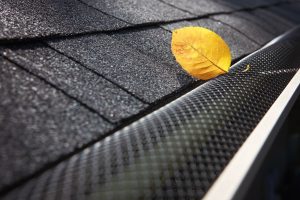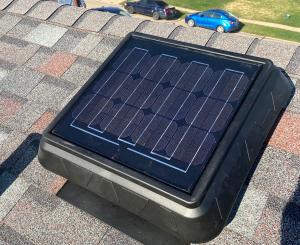Cleaning your roof is an important part of maintaining it. During roof cleaning, your focus should be on removing the algae or moss growth. Why? If you let algae and moss spread on your roof, it will thicken and degrade your roof’s quality. They’ll just keep coming back. The moss also allows other debris to more easily build up on your roof. This results in an unnecessary roof leak and damage to your home. This means your cleaning process needs to be a little more involved than just removing debris or hosing it off with some water. So how do you do it the right way? We dig into the right chemicals for cleaning your roof to prevent algae and moss and how to prevent regrowth today.
Choosing The Right Chemicals
Like we said before, you can’t just clean off your roof with water and expect it to remove moss and algae growth. If you search online, you’ll see hundreds of posts on roof-cleaning methods. In less than 10 minutes, you’ll sign off convinced that all you need is a few gallons of household bleach and a power washer set at its lowest setting. We don’t recommend this approach. Even at low pressure, a power washer can seriously damage shingles. Plus, chlorine bleach is a corrosive agent that can damage metal roof flashings, gutters, and downspouts. It can lighten the color of your roof and “bleach” anything the over-spray contacts. The runoff of this also harms plants.
Here’s the kicker. Bleach may kill the top layer of algae and lighten the stains, but it doesn’t kill the underlying algae. So the algae colony gets right back to work.
Therefore, it’s important to choose the right chemicals for cleaning your roof. Sodium hydroxide products work better than bleach and are less harmful to vegetation. But they’re also corrosive, and using them requires you to don full protective gear.
Your best bet is to look for a roof-cleaning product that’s non-corrosive and safe for the environment.
Chemical Ratios For Cleaning Roof Shingles
Start with the lightest mixture first and then increase the amount of sodium hypochlorite as needed.
- 75% Sodium Hypochlorite – 25% Water – We would use this mixture for hearty algae, fire moss, and lichen.
- 50% Sodium Hypochlorite – 50% Water – They could use this mixture for black streaks or gloeocapsa magma, or light black algae.
- 25% Sodium Hypochlorite – 75% Water – You would use this mixture for the lighter Gloeocapsa Magma stains. we wouldn’t use this mixture on fire moss or real hearty algae.
- 5% Sodium Hypochlorite – 95% Water – We start all of our roof cleanings with this mix, as it is the lightest mix we can use to clean a roof effectively without damage.
Tips and Tricks
Once you have your chemicals mixed in your garden sprayer, it’s time to climb on the roof and start spraying. Here are some tips and tricks once you get up there. Please be very cautious when getting on your roof. If you do not feel confident doing this yourself, hire a professional to complete the process.
Less Chemical Is More
Less is more in the sense that you shouldn’t have chemicals running like a river down your roof. If you are using a garden sprayer, you are not likely to get this type of volume out of your sprayer, so you probably don’t need to worry about this portion.
Double Treat Problem Areas
If the algae haven’t disappeared or turned a white color within 5 minutes of applying the first coat of roof cleaning chemical, reapply in the same fashion. Some fire moss and other overgrown moss may give you trouble because it is a much more hearty version of black algae. Your two options are to kill it or remove it from your roof. Spray more or stronger chemicals for cleaning your roof on it, until it turns white, or spray a hotter mix of chemicals on it again until it turns white and is dead.
Re-Soak Plants That Could’ve Been Touched By The Chemicals
It’s very important to re-soak any plants that could have received mist or a coating from the chemical mixture that you just applied to your roof with clean water. If you skip this step, it can cost you your landscape. Re-soaking and rinsing your plants after you have applied your chemicals for cleaning your roof ensures your plants will live a long life after your roof cleaning treatment has done its work. You especially want to do this if you know that you have gotten some over-spray on the plants previously. Do not skip this step!
Preventing Regrowth
Depending on the weather, you can expect algae regrowth in as little as one year. There are two ways to slow the regrowth process. One is to install zinc or copper strips along the entire ridge. Theoretically, rainwater picks up algae-killing ions and spreads them over the roof. In reality, the protection falls short because algae can still feed off humidity when it’s not raining.
The second method is to spray on a coating of stain-blocking solution. A stain-blocking product can buy you up to three years of protection from algae. If you decide to try it, apply it shortly after you’ve cleaned the roof.
Whether you install the metallic strips or apply the stain-blocking solutions, you’re still going to experience algae regrowth sometime down the road. Get back up on your roof often and clean it early, so the stains don’t set in permanently.
Final Thoughts
We don’t recommend you do this if you don’t have any experience in the proper chemicals for your roof or the proper training to get up on your roof yourself. We also recommend that if you try this on your own, you do not do it alone. Make sure someone is outside with you that can get the proper help from authorities if anything were to happen. If you are scared of heights, or just don’t feel comfortable doing it yourself, let us know. We are always happy to help you, just give us a call at 636-699-0449 so you can have the cleanest, moss-free roof, too!





